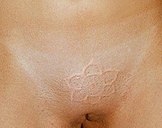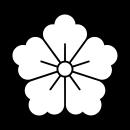Hanabira

Hanabira (花弁) is a form of scarification originating in Japan.[1] It involves the decorative scarring of the mons pubis. The term means petal in Japanese language and refers to the common floral patterns of traditional monshō.
Background[edit]
Concluding from various archaeological and artistic evidence, genital scarification in men and women has been practiced since the Upper Palaeolithic period.[2] The Hanabira scarification was potentially introduced in the Japanese body modification culture and has only recently become popular in western countries.[1][3][4] While the emblem can be a very personal sign and identity symbol in Japan, the western adoption in usually done for purely aesthetical reasons.
Style[edit]
The form of the scar is often inspired by traditional monshō (紋章) or mondokoro (紋所), decorative emblems or symbols that identify a person and are unique for that individual or its family.[4] Most monshōs are monochrome and show the stylized representation of a plant, oftentimes floral elements, or an animal in an edged circle. (see: Gallery of representative kamon «monshō» by theme) Hanabira may also take the form of stylized kanji (漢字).
Method[edit]

The desired patterns or lettering are cut into the skin with a scalpel. To keep the incisions from simply growing together, wound healing is intentionally delayed so that a visible scar develops after some time.[5][1]
See also[edit]
References[edit]
- ↑ 1.0 1.1 1.2 Schnittiger Trend? Scarification statt Tattoo - Stylight
- ↑ Angulo, Javier C., Marcos García-Díez, and Marc Martínez. "Phallic decoration in paleolithic art: genital scarification, piercing and tattoos." The Journal of urology 186.6 (2011): 2498-2503. doi:10.1016/j.juro.2011.07.077
- ↑ Narben, Narbenbildung, Narbenentfernung, Skarifizierung - Narben
- ↑ 4.0 4.1 Abendroth, A. (2009). Bodymodification. Körpermodifikationen im Wandel der Zeit. Tattoos, Piercings, Scarifications. ISBN 9783866081123 Search this book on
 .
.
- ↑ Cutting Tattoos: Ziernarben statt Tinte - Desired
This article "Hanabira" is from Wikipedia. The list of its authors can be seen in its historical and/or the page Edithistory:Hanabira. Articles copied from Draft Namespace on Wikipedia could be seen on the Draft Namespace of Wikipedia and not main one.


